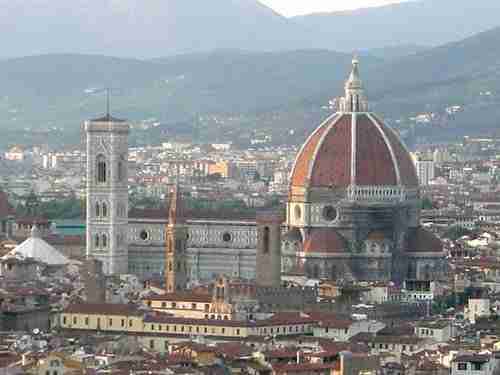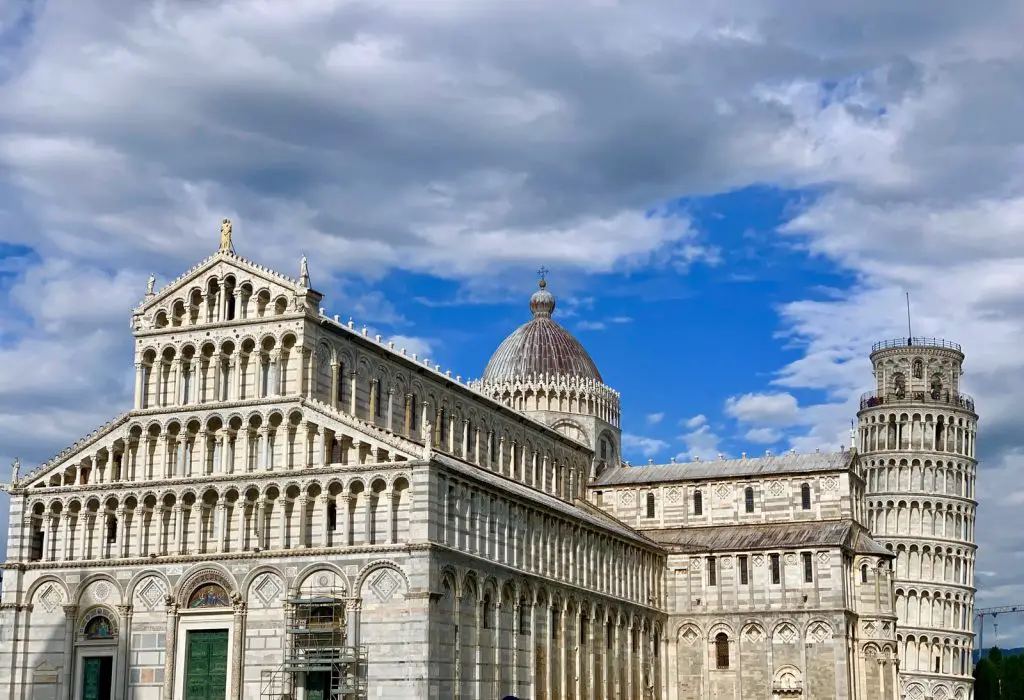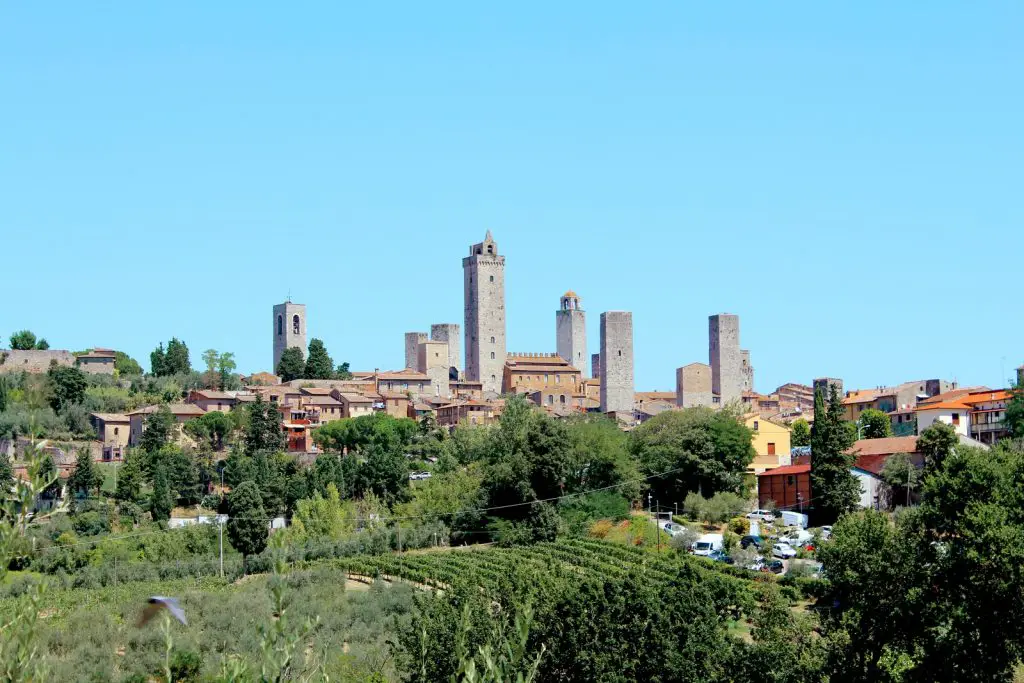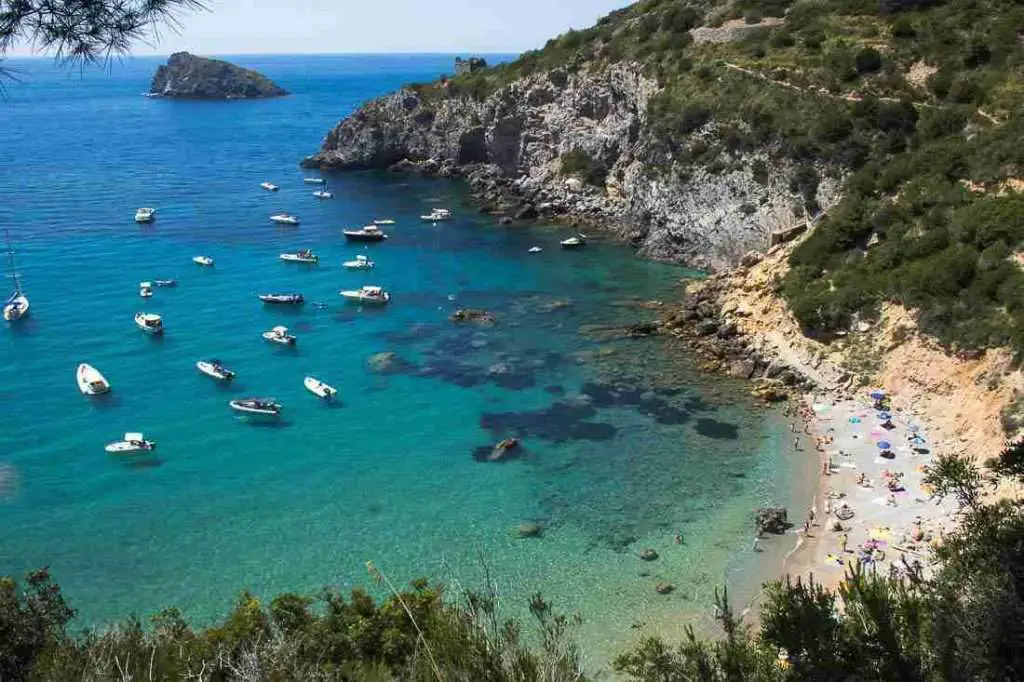Tuscany Travel Guide
A harmonious landscape of vineyards, olive groves, and rolling plains dotted with cypress trees, Tuscany is one of the most beautiful regions in Italy. One could easily spend an entire vacation here visiting historic towns, touring wineries, and taking in the serene scenery.
Florence, the capital of Tuscany and one of Italy’s most famous destinations, is a model Renaissance city full of fantastic art, churches, museums, and boutiques. Most visitors to Tuscany make Florence their base and take a day trip or two to other famous cities like Pisa or Siena; the countryside; or the beach.
Tuscany Map
With an area of 22,987 km/8,877 mi, Tuscany is the fifth largest region in Italy and roughly the size of the U.S. state of New Jersey or the country of Belize.
Tuscany is bordered by five other regions: Liguria, Emilia-Romagna, Le Marche, Umbria, and Lazio.
That means that not only is Tuscany a great region to visit on its own. But it is a good base for exploring other parts of Italy, including Cinque Terre (Liguria), Bologna (Emilia-Romagna), and the hill towns of Umbria. It takes approximately one to 1.5 hours to travel by high-speed train from Florence to Rome.
Where to Go in Tuscany

Florence
Heart of the Italian Renaissance, the Tuscan capital captivates visitors (and residents) with its huge cathedral Santa Maria del Fiore, aka the Duomo, and incredible art treasures in the Uffizi Gallery.

Pisa
Pisa is home to the Leaning Tower, which is the bell tower component of the religious buildings on the Campo dei Miracoli. Like Florence, Pisa straddles the Arno River.

Lucca
Lucca, situated north of Pisa, is a lovely town. It was once a Roman settlement and its main square, Piazza del Anfiteatro, was built around where the Roman amphitheater once stood. Lucca is ringed by walls that you can walk on.

Siena
Best known for its twice-yearly Palio horse race, Siena is a stunning medieval city. Its most recognizable structures are the slender Torre del Mangia, part of the Palazzo Pubblico, and the black-and-white-striped Duomo.

Chianti
Chianti is a wine-growing subregion between Florence and Tuscany. Many return travelers to Tuscany, especially those who like wine, make a base in the Chianti countryside and take side visits to Florence and Siena. Or vice versa.

San Gimignano
Sometimes called “Medieval Manhattan,” San Gimignano is known for the multiple medieval towers in its historic center. A UNESCO World Heritage Site, the city is about halfway between Florence and Siena.

Arezzo
Arezzo is a small city that boasts a magnificent fresco cycle by Piero della Francesca. It makes a good base for exploring eastern Tuscany and its olive groves as well as the towns of Umbria.

Cortona
Cortona, in the province of Arezzo, has become popular over the years thanks to the overwhelming success of Under the Tuscan Sun. But it is also home to a beautiful Renaissance cathedral and artworks.

Tuscan Islands and Beaches
Tuscany also has a string of islands known as the Tuscan Archipelago. The most famous and largest of these is Elba.
Must-See Attractions in Tuscany
Tuscany is home to some of the most famous symbols of Italy, including the Leaning Tower of Pisa and Michelangelo’s David statue in Florence.
Tuscany is also home to some of the most UNESCO World Heritage Sites in Italy. In fact, entire cities in Tuscany are UNESCO sites. These include:
- Historic Centre of Florence
- Historic Centre of San Gimignano
- Historic Centre of Siena
- Historic Centre of the City of Pienza
- Medici Villas and Gardens near Florence
- Montecatini Terme, one of the Great Spa Towns of Europe (shared with 10 other towns in 6 other countries)
- Piazza del Duomo, Pisa (includes the Leaning Tower)
- Val d’Orcia
You could easily plan a one-week itinerary visiting only Tuscan UNESCO sites. But there are many ways to tackle a Tuscany itinerary. Here are some typical ways to plan a one-week stay in Tuscany.
Itineraries for Tuscany
Some of the following itineraries include two to three days in Florence. You can read more about what to do in Florence here.
Florence, Siena, and Chianti countryside. Siena is about one hour away from Florence by car and 1.5-2 hours by train or bus. In between them lies one of the most famous areas in Italy for wine — Chianti. Spend at least one night in Siena in order to experience its medieval mood by night. Greve in Chianti, Castellina in Chianti, and Radda in Chianti are three of the best-known villages within Chianti (sometimes called Chiantishire in English).
Florence, Siena, and San Gimignano. See itinerary above. But instead of stopping in Chianti, go further south to San Gimignano. This city of medieval towers — “medieval Manhattan” — is a UNESCO site.
Florence, Pisa, and Lucca. Pisa is well-connected to Florence thanks to it being Tuscany’s international airport hub. A lot of people do a day trip to Pisa, but I recommend spending at least one night there, even though you can see the Leaning Tower and nearby sites in a few hours. Pisa is a pretty town and home to a large university, so there is often a buzz here at night that you won’t find during the day. Lucca is an elegant city, surrounded by walls. Its center is based around the plan of a Roman amphitheater that was once here.
Florence, Cortona, and Arezzo. East of Florence is Cortona, the town made famous by the book Under the Tuscan Sun. Many tourists are drawn to Cortona because Frances Mayes’s vivid, loving descriptions of the town, so it can get packed in the high season. Nearby is the city of Arezzo, whose San Francesco church has an unmissable fresco cycle by Piero della Francesca. You may also wish to combine this itinerary with side trips to Sansepolcro and/or Anghiari.
Best Time to Go to Tuscany
The best time to go to Tuscany is from April to late May and from September through October. These months have milder weather and fewer crowds than summer. Temperatures range from daytime highs of 66°F/19°C to 81°F/27°C in the spring to – perfect weather for strolling around cities or the countryside and dining outdoors. It is more likely to rain in April.
June, July, and August are the busiest and hottest months to visit Tuscany. They are also the most expensive. Tuscany can get very hot in the summer with temperature averages ranging from 81°F/27°C to 86°F/30°C – if you are lucky. Over the past decade or so, Tuscany and many other parts of Italy have experienced summer heatwaves with temperatures sometimes reaching the mid-90s (35°C) or higher.
March and November are typically the rainiest months. But they can be good times to visit if you want to avoid crowds and get a good deal on a hotel.
The coldest months in Tuscany are December, January, and February. December is festive with Christmas lights and decorations. January and February are cold and often dreary with a few bright, sunny days poking through. Winter is the low season in Tuscany because of the weather, which means it’s a great time to score a hotel deal.
Festivals and Holidays in Tuscany
- February – Carnevale/Carnival, particularly lively in Viareggio
- March 25 – Feast of the Annunciation aka Florentine New Year
- March 25 – National Dante Alighieri Day
- Easter – Scoppio del Carro (Florence)
- May – Maggio Musicale Fiorentino (Florence)
- June 24 – Feast of St. John the Baptist, Florence’s patron saint and Calcio Storico, a soccer match played in Piazza Santa Croce
See the Italy calendar for details on public holidays in Italy.
Top Tours in Tuscany
Where to Stay in Tuscany
Hotel Botticelli. Florence. I am not particularly loyal to hotels or brand names, but I am to Hotel Botticelli — for a good reason. This comfortable and elegant hotel is near the Mercato Centrale, a fantastic food market in central Florence.
Al Mercato B&B. Siena. Basic accommodations but very close to the center of Siena. A practical choice for a one-night stay if you’re on a budget.
Hotel La Cisterna. San Gimignano. This hotel couldn’t have been in a better location. It fronts the piazza of the same name and my room had a small balcony from which I could view the Tuscan hills. Quiet, clean, a good value. I was very pleased and would have stayed longer had my itinerary allowed it. One thing to note is that if you’re driving, it’s rather complicated to get to the hotel while properly observing ZTL restrictions. That’s just part of the deal when staying in a UNESCO Heritage Site. I had to park rather far away, but the city center streets are made of smooth brick, so you can easily wheel your suitcase from point A to B.
Il Molinaccio di Montepulciano. Montepulciano. This is the kind of rustic property I dream of. Large rooms with sturdy farmhouse furniture, a manicured lawn giving way to one of the best-looking swimming pools I’ve ever swum in. Breakfast was ample (didn’t expect scrambled eggs!). A purring cat lazed on the patio chairs when it wasn’t chasing lizards and beetles. The place makes its own wine, which is to be expected in a place like Montepulciano.
Borgo Magliano Resort. Magliano in Toscana (near Maremma, southern coast). This is a self-catering resort with a large swimming pool and a restaurant. Borgo Magliano Resort sits on a hill across the valley from the lovely little medieval town of Magliano and is a short drive away from olive groves, vineyards, and the beach. I have stayed here with my family at least three times and it seems to be a hit with families from Italy and Europe.
